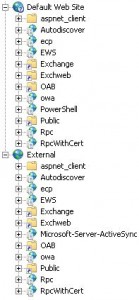Import-Module ServerManager
Add-WindowsFeature NET-Framework,RSAT-ADDS,Web-Server,Web-Basic-Auth,Web-Windows-Auth,Web-Metabase,Web-Net-Ext,Web-Lgcy-Mgmt-Console,WAS-Process-Model,RSAT-Web-Server,Web-ISAPI-Ext,Web-Digest-Auth,Web-Dyn-Compression,NET-HTTP-Activation,RPC-Over-HTTP-Proxy -Restart
Set-Service NetTcpPortSharing -StartupType Automatic
Install:
http://www.microsoft.com/downloads/da-dk/details.aspx?displaylang=da&FamilyID=60c92a37-719c-4077-b5c6-cac34f4227cc
http://www.microsoft.com/downloads/en/details.aspx?FamilyID=5cd4dcd7-d3e6-4970-875e-aba93459fbee&displaylang=en
Get-OabVirtualDirectory -server EXCH | Set-OabVirtualDirectory -InternalUrl https://exch.DOM.local/OAB -ExternalUrl https://webmail.Mydom.dk/OAB
Get-WebServicesVirtualDirectory -server EXCH | Set-WebServicesVirtualDirectory -InternalUrl https://exch.DOM.local/EWS/Exchange.asmx -ExternalUrl https://webmail.Mydom.dk/EWS/Exchange.asmx
Get-OwaVirtualDirectory -server EXCH | Set-OwaVirtualDirectory -InternalUrl https://exch.DOM.local/owa -ExternalUrl https://webmail.Mydom.dk/owa
Get-EcpVirtualDirectory -server EXCH | Set-EcpVirtualDirectory -InternalUrl https://exch.DOM.local/ecp -ExternalUrl https://webmail.Mydom.dk/ecp
Get-ActiveSyncVirtualDirectory -server EXCH | Set-ActiveSyncVirtualDirectory -InternalUrl https://exch.DOM.local/Microsoft-Server-ActiveSync -ExternalUrl https://webmail.Mydom.dk/Microsoft-Server-ActiveSync
Get-ClientAccessServer EXCH | Set-ClientAccessServer -AutoDiscoverServiceInternalUri https://exch.DOM.local/Autodiscover/Autodiscover.xml
enable-OutlookAnywhere -Server ‘EXCH’ -ExternalHostname ‘webmail.Mydom.dk’ -DefaultAuthenticationMethod ‘Basic’ -SSLOffloading $false
Remember to use a SSL SAN Certificate.
(With alternative names)
exch
exch.dom.local
autodiscover.Mydom.dk
If you have alot of domains you can setup a SRV record on every domain: _autodiscover._tcp.info-Mydom.dk exch01.hostingprovider.dk
Set external EWS url:
Set-WebServicesVirtualDirectory -identity “CAS1\EWS (Default Web Site)” -externalurl https://outlook.dom.com/EWS/Exchange.asmx
Set-WebServicesVirtualDirectory -identity “CAS2\EWS (Default Web Site)” -externalurl https://outlook.dom.com/EWS/Exchange.asmx
Get-WebServicesVirtualDirectory | select name, *url* |fl
https://outlook.dom.com/EWS/Exchange.asmx
